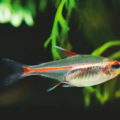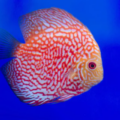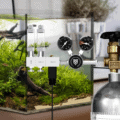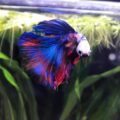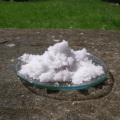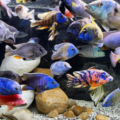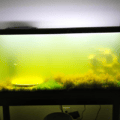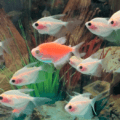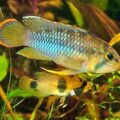Do you want to add a burst of colors to your aquarium with a single fish? Introducing the vibrant freshwater Mikrogeophagus ramirezi, a.k.a Ram Cichlid, with care tips.
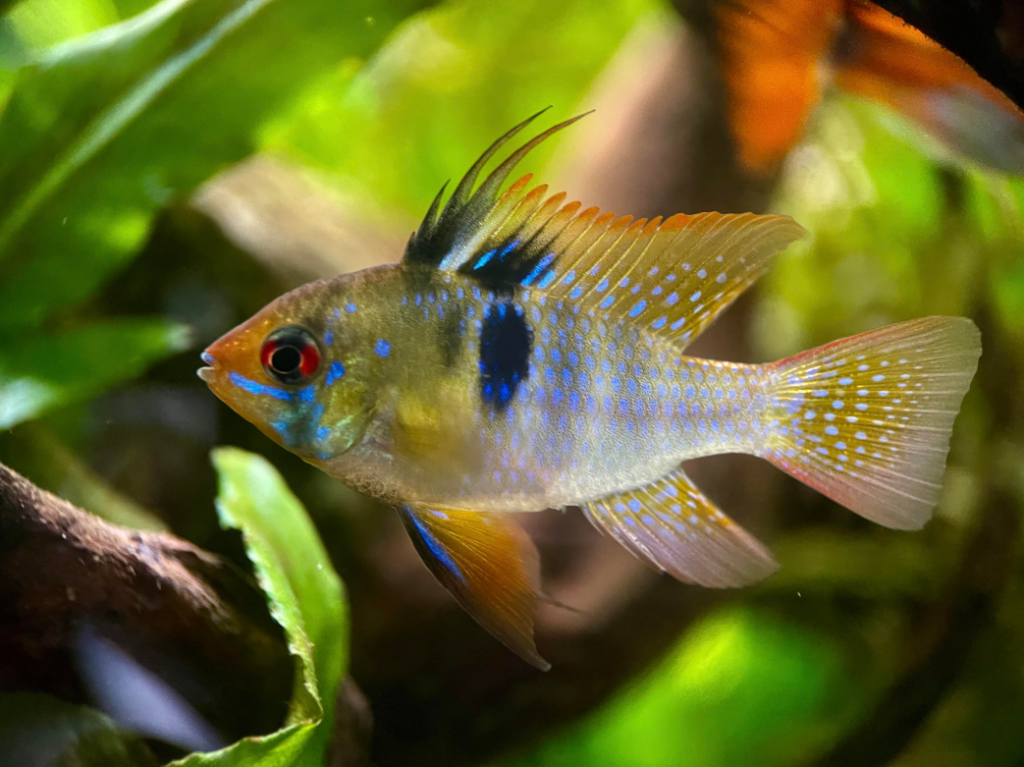
Do you want to beautify your aquarium with a colorful freshwater fish that offers personality and beauty? You should consider adding Mikrogeophagus ramirezi, a.k.a Ram Cichlid, Blue German Ram, and Ram Dwarf Cichlid, to your tank.
Don’t worry if you don’t know the first thing about Mikrogeophagus ramirezi care. That’s why you’re here. This Ram Cichlid overview contains important information on owning this species as an aquatic pet.
I’m starting by identifying a Ram Cichlid, and then we’ll discuss creating the perfect tank environment, feeding routine, breeding, tank mates, health care and more.
Appearance of Mikrogeophagus ramirezi: A Vibrant Display of Nature

Identifying Ram Cichlids is easy because they have distinctive scale colorations and traits that separate them from other cichlids. This species is naturally tiny and grows 2 – 3 inches long as an adult. But let’s talk about its more interesting features.
Color Pattern

Mikrogeophagus ramirezi colors combine multiple shades of blue and orange in distinct patterns. The scale pattern is an electric blue and gold swirl on the body, highlighted with spotted metallic blue fins.
Its face and fins will also have a variation of reddish-orange to gold shade, and a closer look at the body will show you black stripes on its scales.
Unique Traits
Besides their beauty, aqua-enthusiasts love the Ram Cichlids for their unique traits, which include coloration intensity during courtship, breeding, and territorial behaviors. Other than that, this vibrant aquarium fish is typically peaceful and makes for a good tank mate.
Creating the Perfect Tank Environment for Mikrogeophagus ramirezi
Here’s a guide on creating the perfect Mikrogeophagus ramirezi tank setup.
Tank Size and Layout
Because Ram Cichlids are small, a simple 20-gallon rectangle tank per pair is okay unless you have a community, then make it 50-gallons or more.
Water Parameters
As a freshwater species, Mikrogeophagus ramirezi thrives in conditions matching the Natural habitat for cichlids.
| Temperature | 78 – 85℉ |
| pH level | 5.5 – 7 (Slightly Acidic) |
| Hardness | 3-10 dGH |
Substrate and Decor
Keep your tank decor and substrate safe and simple to avoid harming your delicate Ram Cichlids.
| Substrate | Decor |
| For the tank’s base, use the following: Fine SandSmooth Gravel | For other pieces, add decor that looks like the Amazon River. Try these: Driftwood Live Leaf like Java Moss Fern |
Once you’ve settled your Ram Cichlid aquarium conditions, it’s time to feed your pets.
Dietary Needs of Mikrogeophagus ramirezi
Feeding Mikrogeophagus ramirezi is simple because they’re omnivores who eat plants and live food. Now, you’re wondering how you can strike a balance. I’ve got you.
Diet Suggestions
Based on function, I split the cichlid diet into two – staples and supplements. Staples are general foods they must eat daily, and you can vary the supplements based on their immediate health needs.
| Food Type | Examples | Purpose |
| Staples | Commercial food like Pellets and Flakes specifically made for cichlids | Muscle building and overall health |
| Supplements | Frozen, Freeze-Dried, and Live food like Bloodworms, Daphnia, and Brine Shrimps.Vegetables like Blanched zucchini and spinach | Hunting instincts and protein Improves Gut Health, Indigestion, and Reduces Constipation. |
Feeding Tips
below, we have listed some Ram Cichlid diet tips to make feeding easy.
- Create a feeding routine: Pick a time for feeding every day.
- Portion Control: Serve only portions your Ram Cichlids can finish in less than 3 minutes.
- Frequency Control: Don’t feed your pets more than twice to three times daily.
If you’ve followed this guide so far, you’ve mastered the first steps in maintaining fish health.
For more on feeding your aquatic pets check out The Ultimate Guide to Fish Food: Pros and Cons & Best Choices!
Breeding Mikrogeophagus ramirezi: A Rewarding Experience
Breeding Mikrogeophagus ramirezi is interesting because of its captivating reproductive behavior.
Select breeders based on natural bonds or preferred traits. Note that the males have longer dorsal fins while females have rounder bellies with pinkish and reddish heads.
Breeding Conditions
Add a flat surface to the substrate for the females to lay their eggs.
| Tank Size | 20-gallons |
| Temperature | 80 – 84℉ |
| pH | 5.5 – 6.5 |
| Hardness | 3 – 5dGH |
| Diet | More Protein |
During Ram Cichlid reproduction, the males will chase the females, who’ll lay their 100 – 300 eggs on the flat surface you’ve provided for fertilization.
Both Ram Cichlids will protect and fan their eggs before they hatch in two to three days.
Fry Care
Within five days of hatching, your Ram Cichlid fry starts free-swimming. Before then, they’ll survive on consuming their yolk sacs, infusoria, and liquid fry food. So, raising aquarium fish fry is your task. During this period, the water quality should be optimal for good health.
Choosing Compatible Tank Mates
Choose only compatible tank mates for Mikrogeophagus ramirezi to prevent agitation and stress. When selecting peaceful aquarium companions, you must consider size, environmental needs, feeding, and temperament.
Compatible Species
The following are suitable fish for Ram Cichlids tanks:
| Rasboras | |
| Tetras | |
| Corydoras | |
| Otocinclus |
Avoided Species
Don’t pair these small fish with fin-nippers, overly larger or aggressive fish to prevent predation and bullying.
Preventing Health Issues
If you’ve followed this guide strictly, you have all the health tips for preventing cichlid diseases. But your pets may still get sick from natural causes and slight mistakes.
Preventative Measures
- Maintain optimal water conditions with a good filtration system and regulated feeding.
- Pair Ram Cichlids with only compatible tank mates
- Feed them a proper diet
- Keep them in ideal tanks
Follow these tips for healthy aquarium fish care.
Signs of Illness
| Signs of Illnesses | Illnesses | Causes | Treatment |
| Agitation | Stress | Poor Water Condition Aggressive Tank Mates | Improved water quality |
| Visible parasites | Infection | Poor Water Quality Poor Diet | Anti-parasite medication |
| Faded Coloration, White Spots, Red Streaks | Ich, Septicemia | Bacterial infection in contaminated water | Antibacterial med |
| Bloating | Dropsy | Organ Failure, Poor Diet | Fasting, Feeding VegetablesVisit to the Vet |
Check out How to Treat Ich Outbreaks in Your Freshwater Fish for more information on Ich!
Extending the Lifespan
Ram Cichlids typically live for 2 – 4 years, but read the following lines if you want lifespan tips on extending cichlid life for an extra year.
| Lifespan Factors | Care Tips for Longevity |
| Water Condition | Maintain and Stabilize Optimal water conditions |
| Diet | Maintain a balanced diet |
| Environment | Create an ideal tank environment |
| Stress | Reduce stress with compatible tank mates |
| Health | Prevent and Treat illnesses quickly |
| Socialization and Natural Behavior | Encourage natural behavior with live food and compatible tank mates |
For long-term Ram Cichlid care, you must make these practices a daily routine, and I can proudly tell you you’re ready to take care of this species.
Conclusion
I hope you’ve enjoyed reading this Mikrogeophagus ramirezi care guide and are planning to use these Ram Cichlid aquarium tips I’ve shared so far.
Before I leave you, let’s make sure you’re ready for complete cichlid care. Scroll back to the top to confirm you have everything you need.
Is your tank suitable for housing Ram Cichlids?
Do you have the right food?
Are you prepared to monitor tank maintenance?
Are you educated on preventing illnesses?
If you checked all the boxes, congratulations! It’s time for your Mikrogeophagus ramirezi ownership journey.

